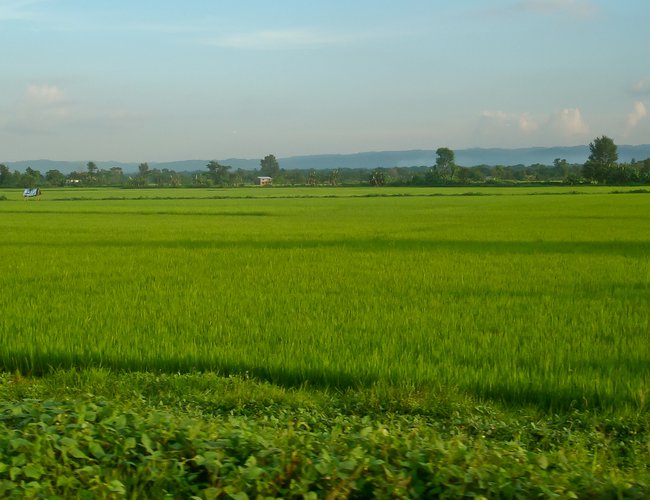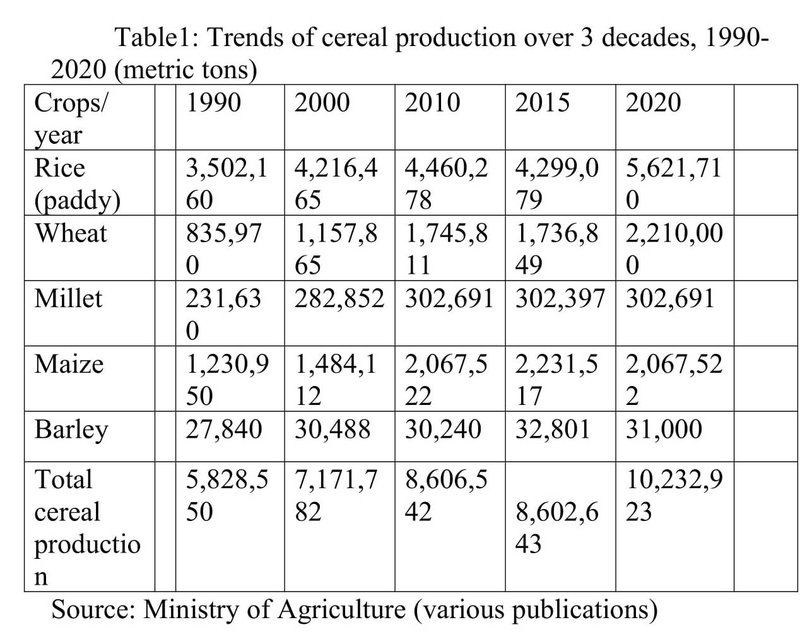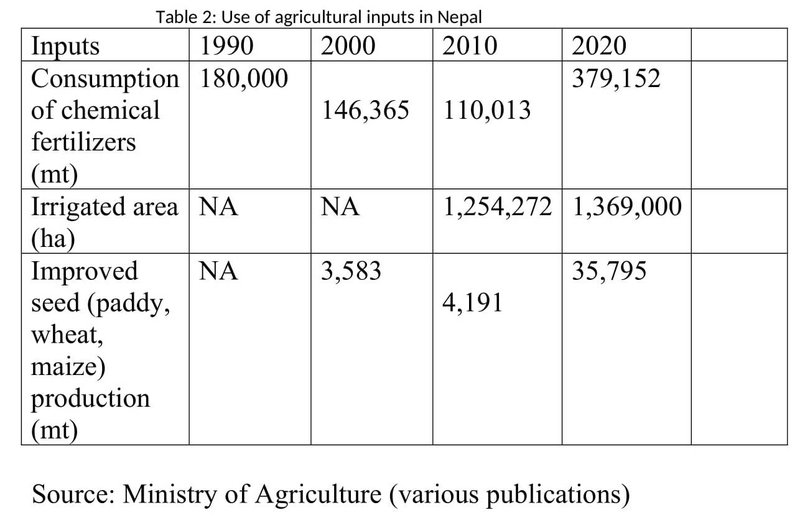
Introduction
Agriculture sector is central to the economy of Nepal. This sectorstill contributesabout one fourth to the gross domestic product (GDP) of the country.Some sixty percent of the total populationdepend on agriculture for their livelihood. Nepal’s agricultureindustry is mostlyat a small-scale and subsistence level. Farmers, especiallythose who reside in hilly areas, practice integrated farming systems, consisting of crops and livestock. The average farm size in the country has now declined to less than 0.5 ha from 0.8 ha in 2003/04. According to CBS (2013), 52.7% of households operate with less than 0.5 ha, 42.9 % operate at 0.5-2ha while only 4.4% function at 2ha and above. Since the majority of farmer households operate at less than 0.5 ha, the production is not sufficient to support their families throughout the year. Consequently, millions of youths have been forced to seek employment in Gulf and East Asian Countries as there are barely any opportunities within the country.
Food and nutritional security
Nepal used to be a food surplus country until the early nineties. With the exception of the mountain and some hill districts, all of the Terai region and a large number of hill districts experienced food surplus. Around the late seventies, the then government had even established seven rice exporting companies in various parts of the country, with the objective to exportrice. In fact, these companies were able to export millions of tons of rice to our neighboring countries India and others. However, they were dissolved in 1988 as Nepal's cereal production was just enough to meet the domestic demand. With the outpacing of Nepal's population growth rate by the growth rate of cereal production since the early nineties, this country has now become a major rice importer. In the fiscal year 2021-22 alone Nepal imported rice amounting to more than thirty billion rupees. This is in increasing trend mainly because of a number of faulty policy decisions of the government. .
In the last three decades, per capita availability of cereal production in the countryhas been rather stagnant.Like in many other developing countries Nepal’s agricultural environment is highly vulnerable to human or natural factors such as extreme weather events, natural disasters, resource constraints, labor and armed conflicts. The Meteorology Department has forecasted about 30 percent less rainfall in 2023as compared to normalyears.Frequent floods, landslides and droughts in certain parts of the country are already having a severe impact on agricultural production. This has contributed to the sharp increase in food prices, thereby making it more difficult for poor families to afford food. Overcoming it has been a major challenge to the government.
Like elsewhere in the world, Nepal also has been vastly impacted by the COVID 19 pandemic, supply chain disruptions, and lower income levels, making way for an increased population under the poverty line. Consequently,food insecurity in the country has continued to increase, thus exposing the vulnerability of external food supply. The situation has even worsened after the outbreak of the Russia-Ukraine war last year. Prices of food including vegetable oils, roots, beans and sugar have increased by20-25 percent. Such rises havenot only increasedinequality between the rich and poor, but have also created discontent among the poor. These issueshave put severe pressure on the government to start thinking to enhance ways to increase the agricultural productivitysharplyand to reverse agricultural production trend in the country.
Trends of cereal production
The Nepalese agriculture sector is heavily dependent onseasonal rainfall. According to the recent statistics released by the Department of Irrigation, only about28% of the cultivated land has irrigation facilities. Paddy, wheat and maize are the major cereal crops, while millet, buckwheat and barley are the minor cerealsgrownin Nepal. Likewise, oilseed, sugarcane and potato are the principal cash crops. Table 1below shows the trends of the major cereal production overa period of three decades.

The table shows that rice production increased by about 60percentin between 1990 and 2020, whereas other cereal crops namely maize, wheat, millet and barley grew by68 percent, 164 percent, 31 percent, and 11 percent respectively. These statistics shows that the growth trend of cereal productions in Nepal over a period of three decades has not been impressive except for wheatwhose production grew by almost three times. In fact, the growth trend of barley and millet has been quite disappointing, while the growth of maize production has been subpar. By and large, agricultural development has been very sluggish, and has failed to keep pace with the country’sincreasing demands of cereal grains.The yields of major food crops in Nepal have been much lower than other South Asian countries.
Underlying causes of low productivity
Adequate studies have not been done to understand the underlying causes of low agricultural productivity in Nepal.Some studies have identified thatlack of irrigation and heavy dependence on rainfall as major contributors of low productivity, whereasothers refer inadequate use of chemical fertilizers as the cause. Fewhave found thatthe limited access to market and increasing role of unregulated middleman have contributed to discourage farmersto take on risks to increase productivity. Others have identifiedland degradation as amajor contributor of low productivity, while some have suggestedthat the agricultural extension services, which are extremely crucial for enhancing agricultural productivity,have beengrossly inadequate and unsatisfactory. There has not been any specific study to find out which factor is most responsible for the stagnation of productivity.
Agricultural inputs
Agricultural inputs, namely irrigation, chemical fertilizer, improved varieties of seeds and extension services are important for increasing the yield rates of the crops.Data on the use of agricultural inputs in Nepal is very scarce. However, attempts have been made to provide some information in Table 2 below on the use of various agricultural inputs over time in Nepal:

Per capita consumption of chemical fertilizers andof improved seeds of major cereal crops, namely paddy, wheat and maize,are extremely low in Nepal.Total demand of chemical fertilizer is estimated to be around 1.2 million metric tons, whereasits supply in 2020 was about 379,000 metric tons, almost three times less than its demand. This huge gap in fertilizer demand in the country,especially in the hilly districts, used to be met by local organic manures including cow dung. However, in recent years, asmany youths have migrated to other countries for employment, there has been a sharp decline in livestock held by the farmers in all districts of the country. Consequently, the farmers have been forced to leave their land as fallow. The chemical fertilizers supplied by the government are highly inadequate. Moreover, the farmers do not get the fertilizer as and when they need it because of highly inefficient distribution systems of the Agricultural InputsCompany of the government. The government has been planning to establish a fertilizer manufacturing plant for many years, but it has been limited only to paper. Nobody knows when this plan will ever be implemented.
Unavailability of good quality hybrid seeds at the right time and place stands as the main constraint in improving the economic status of the farmers. Table 2 above shows the production of certified/improved seeds of cereals is highly unsatisfactory. Therefore, farmers have no choice but to depend on the imported seeds which are not only expensive but also of questionable quality at times.
Irrigation is the most important input for increasing agricultural production. However, more than seventy percent of cultivated land in Nepal still must depend on monsoon rain for irrigation. Irrigating farmland is crucial for increasing production, thereby helping to reduce the country’s trade gap and build a more secure economy.Despite the availability of water, Nepal has a long way to go to tap its resources to their full potential.Unless heavy investment is made for the development of irrigation systems throughout the country it will not be self-sufficient in food production and meet the increasing demand for agricultural commodities.
Extension services
In general, Nepali farmers continue to rely on traditional farming methods. The agricultural extension services are extremely important to transfer farming knowledge and skills to the farmers. The extension services started in Nepal in themid-sixties. Under this program, the District Agricultural Offices used to employ technicians known as Junior Technical Assistants (JTAs) to assist the farmers to adopt new technologies including the use of chemical fertilizers, improved varieties of seeds, insecticide, etc.
However, these extension services were strained due to lack of staffing and funding.Available statistics show that the Department of Agriculture had 378 extension offices nationwide until about a decade ago. Every agricultural outreach station used to serve more than 11,000 farmers. This meant that one technician was responsible for an average of 1500 farmers as compared to about 400farmers in developed countries. Since these technicians were not well qualified, much technologycould not be transferred to the farmers.However, a few years ago the Ministry of Agriculture introduced a new agricultural extension policy. Compounding farmer’s woes, the current extension service model requires the farmers to go to district centers and sub-centers for assistance. This has left growers in remote areas most in need of support going without it. It should be noted that in some rural areas it takes the farmers, onaverage, more than three hours to reach the nearest service centers because of difficult terrain and lack of transport infrastructure.
Agriculture research
Agriculture has always remained priority sector in Nepal since the beginning of first five-year plan in the mid-fifties. While Nepal's all development plans give high priority to agriculture, the government investment in the Ministry of Agriculture Development (MOAD) has not been very encouraging. The budget allocated to MOAD declined from 3.7 percent of all government spending a decade ago to about 2.6 percent this year. However, in his recent budget speech the finance minister has announced to allocate almost 59 billion rupees foragriculture and livestock development for next year. Even though this amount is more than 3 billion than the budget allocated for the current fiscal year, it is simply inadequate to make the country self-sufficient in agricultural production.During the budget presentations the finance ministers promise every year tomake the country fully self-reliant in agriculture within the next few years through modernization, commercialization, and mechanization of the agriculture sector, but these promisesare yet to materialize.
Since most of the budget allocated for the development of agriculture and livestock goes for salaries and administrative costs; there is limited resource available for programming. Minimal investment in agriculture has hampered efforts to meet the challenges of increasingly volatile weather, especially given Nepal’s agro -ecological diversity. Nepal Agricultural Research Council (NARC) has about 48 specialized research farms across the country. These farms are basically run by political cadres than by scientists. Moreover, in most of these farms including the NARC central office, a large number of the posts are vacant due to recruitment problems. The only agricultural university of Nepal, which could have taken a lead role in agricultural research , is in pathetic condition because of political interventions, nepotism and corruptions. The resources allocated for agricultural research in Nepal is highly inadequate. Declining resource allocation to agricultural research and development will surely have direct implications on attaining the objective of poverty reduction despite investment made on rural infrastructure. When the investment is low, new technology and programs cannot be initiated to generate employment and grow effectively, and thereby alleviate poverty in the country.
Agricultural loans
Inputs needed to increase land productivity, from seed to fertilizer, machinery and irrigation, are scarce nationwide. Farmers hardly get compensation when their crops fail due to volatile weather and other natural calamities, especially given Nepal’s agroecological diversity. Last year, the share of credit provided to agriculture was only about 12 percent of the commercial banks’ total lending portfolio due to perceived high risk of investing in subsistence agriculture. Their preference is rather lending towards housing, motor vehicles and commercial development. It is rather unfortunate that the government- owned Agricultural Development Bank of Nepal (ADBN), which was established in 1968withthesole objective of lending to the farmers, has now moved from being a prime lender in agriculture to other sectors, like other commercial and development banks.
Way forward
From the above analysis, it becomes clear that the future of agricultural development in Nepal is very bleak unless drastic measures are undertaken by the governmentto revamp the agricultural system. The agricultural growth rate has been very disappointing for a long time. The yield rate of cereals is much lower than in other South Asian countries. Once in food surplus, Nepal has now become a net food deficit country. The trend of food import has been alarming. Millions of youths who were working in agriculture in the past have now migrated to Gulf and Southeast Asian countries in search of better employment opportunities.The rural areas have been left with an older and weaker population and more women and children. This has contributed to converting the otherwise cropping areas into fallow land, which is estimated to be around 30 percent of total cultivated land.If Nepal wants to become once again a food surplus country, this trend must be reversed. Some measures are proposed belowthat can possibly help to reverse the trend.
First, Nepal’s farming system continues to be very traditional and rudimentary. In order to stop the out migration of youths from rural areas, it is necessary to think about creating employment opportunities within the agricultural sector itself.What this means is that the government will have to consider introducing policies that will help to move towards agricultural commercialization where possible in the country, taking advantage of the latest available technologies and innovations.Various agro-based food processing industries can be established in different pockets of the country. This can helpcreate employment opportunities for millions of youths who do not have sufficient land to start their own business.
Second, the government should consider introducing policies to encourage farmers to diversify agricultural production. Eating habits of people have now changed. Accordingly, farmers will need to be encouraged to grow crops which are in more demand inthe market.Also, since only about 28 percent of cultivated land in the country is irrigated, the government will need to consider policies to growhigh-value crops such as almonds, cashews, dates, etc. and fruits such as kiwis, avocados, grapes that can be grown in dry areas and does not require much water.
Third, agricultural productivity of Nepal is one of the lowest in the South Asia region.In order to enhance productivity, farmers must have easy access to agricultural inputs including chemical fertilizers, improved varieties of seeds, irrigation, agricultural tools and machineries, etc. There is a dearth of chemical fertilizers in the country; farmers never get access to fertilizers and seeds as and when they need them. The Agricultural Inputs Company, which is the sole authority to import and distribute fertilizers in the country, has a very limited capacity. Under the circumstances, it is important that the government considers allowing private sector to import and distribute fertilizers through cooperatives, under strict government supervision, so that the farmers get fertilizers on time. There are about 7230 agricultural cooperatives in the country. They can play important role in distributing chemical fertilizers and improved varieties of seeds as well as in marketing the surplus agricultural products of the farmers, provided they can be run under strictly regulated conditions. Meanwhile, the government must give topmost priority to establish a chemical fertilizers plant within the country, so that Nepal does not have to depend on the mercy of friendly countries to import fertilizers.Time has come to establish as soon as possiblethe chemical fertilizer plants that have been in discussions since long. .
Fourth, government investment needs to be increased significantly in agricultural research. Now less than o.4 percent of the agricultural sector’s GDP is spent on research, which is far short of the internationally recommended 1 percent. Inadequate investment in research has hampered efforts to address the challenges of increasingly volatile weather and climate change, especially given Nepal’s agro-ecological diversity. The capacity of NARC and its various research farms, which are spread throughout the country, needs to be enhanced by filling up all the vacant scientific staff positions, allocating adequate resources for research, and providing skills improvement opportunities to the employeesas well as maintaining an effective coordination between NARC and agricultural extension offices.
Finally, the commercialbank’s credit facilities for agricultural development must be further increasede. Currently, it is much easier to get loans to purchase vehicles, realestate and consumer itemsthanfor agricultural activities. In 2022, the share of credit provided to farmers and business for agricultural development was about 12 percent. This situation must be changed. Also, the government should seriously consider making the Agricultural Development Bank fully focused on agricultural developmentas was in its original role, and not use it as a commercial bank, and have its branches opened in all gaun palikas(rural municipalities) of the country.
About 18 percent of the population is still below the poverty line. Most of these people live in rural areas, and their main occupation is agriculture. If agriculture investment continues to be low, the government’s poverty reduction efforts may not be achievable. Hence the government must consider to significantly increasing its investment in agriculture by at least 3 to 4 times of the current agricultural budget.
Author is a former Executive Director of the Institute for Integrated Development Studies (IIDS), Kathmandu

















